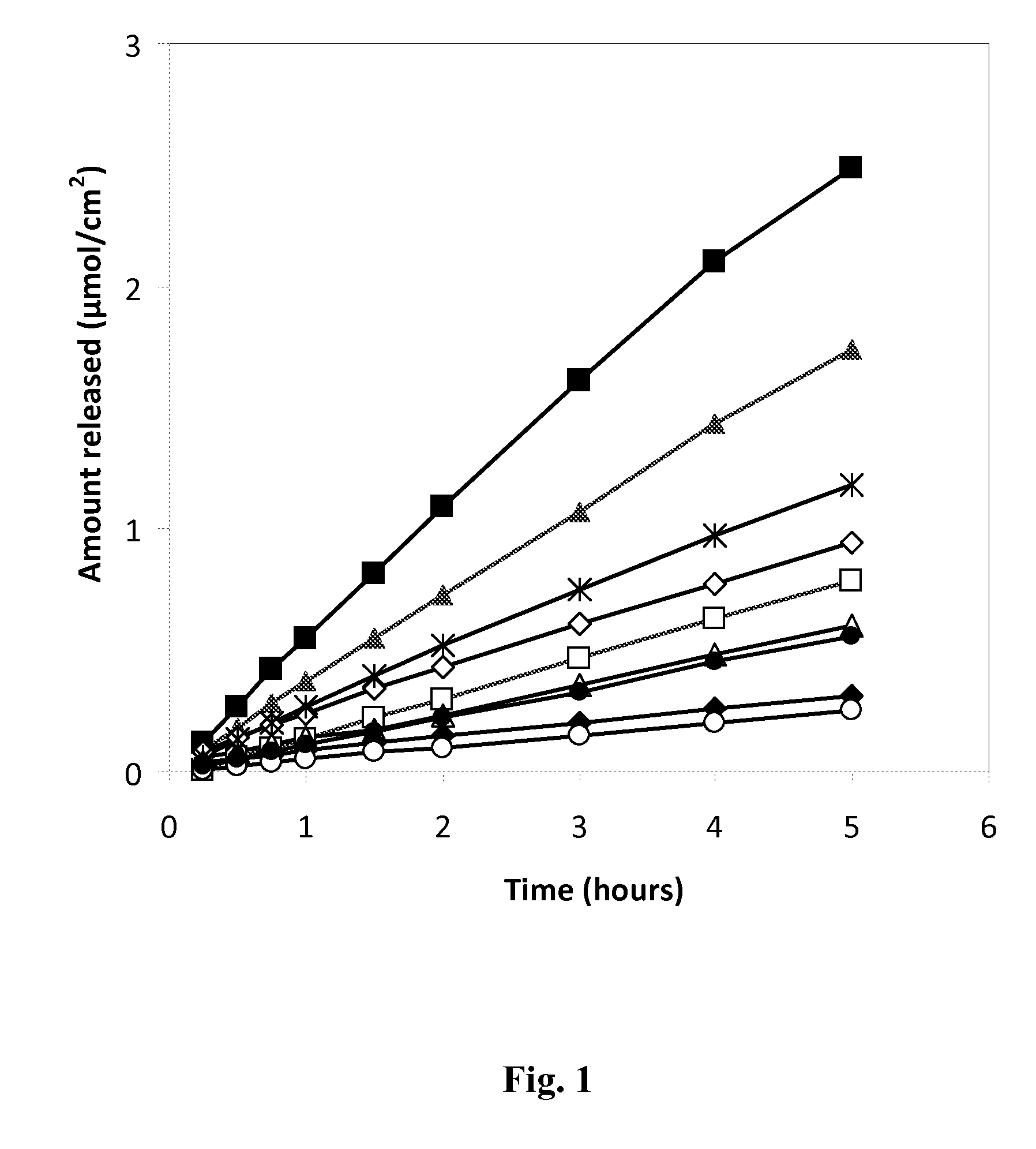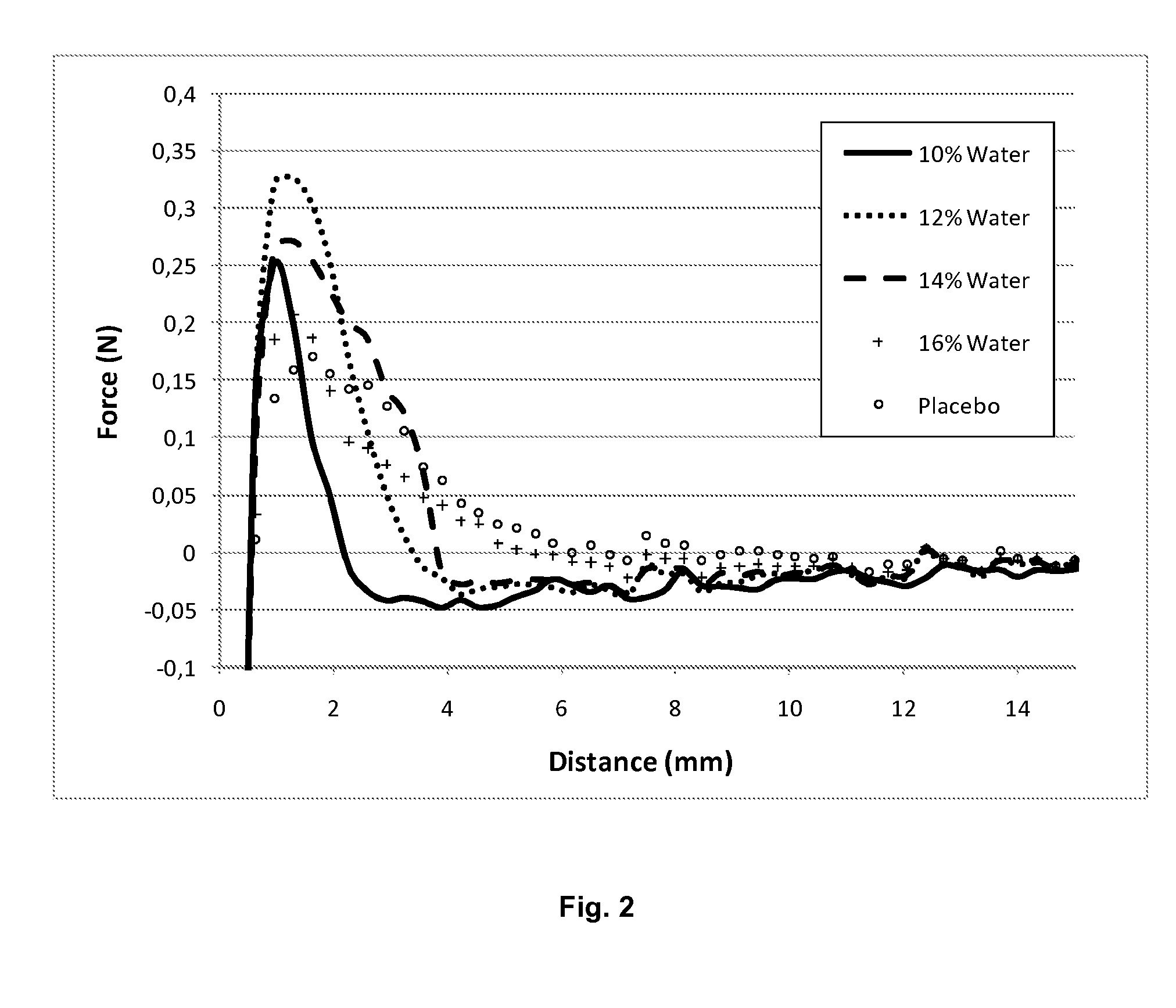Bioadhesive Compositions of Local Anaesthetics
a technology of local anaesthesia and composition, applied in the direction of drug compositions, biocide, heterocyclic compound active ingredients, etc., can solve the problems of poor solubility and stability in aqueous solutions of the base form of local anaesthesia, no particular guidance in these applications, and the acid form is charged and therefore less suitable for passing through biological membranes
- Summary
- Abstract
- Description
- Claims
- Application Information
AI Technical Summary
Benefits of technology
Problems solved by technology
Method used
Image
Examples
example 1
Formulations Using Lyotropic Phases
[0092]The initial tests in Table 2 with the lyotropic phase systems were made in order to establish the feasibility of this approach. It was found that by mixing glycerol monooleate (GMO), oleic acid and water a gel (very likely a cubic phase) was formed. Formulations were prepared where ropivacaine was mixed with GMO, oleic acid and water and a white gel was formed.
TABLE 2Initial tests for the lyotropic phase systems.Water addition refers to the addition of NaOH (aq) for adjustmentto pH 8.5 for the compositions containing local anesthetics.OleicGlycerolRopivacaineGMOacidformalWater(%)(%)(%)(%)(%)pHAppearance—4545—105Gel—3535—302.6Gel—2525—501Gel8414110—Clear, viscoussolution532.532.530—Clear, viscoussolution8212150—Clear solution542.542.5—10Clear, viscoussolution (pH 9)537.537.5—20White gel (pH 9)532.532.5—30White gel (pH 9)
example 2
Formulations with GMO and Oleic Acid
[0093]The composition ranges of the different excipients are coupled to the amount of ropivacaine in the formulation. In Table 3, formulations with different ropivacaine concentrations are presented. The table is sorted after increasing ropivacaine concentration in the formulation. Different combinations of the components offered a gel formulation where ropivacaine was solubilized. The phase behavior of the formulations was investigated with cross-polarizers to distinguish between lamellar and cubic phases in the gel formulation.
TABLE 3ARopivacaine, lipid - GMO, organic acid - oleic acidFormulations investigated for in-situ gellingOleicGlycerol RopivacaineGMOacidformalWater(%)(%)(%)(%)(%)Appearance425252323Viscous, white624242323Gel (cubic)726262517Gel (cubic)7373799Viscous, clear solution72828279Clear solution71919459Clear solution1021491010Clear solution1018421020Clear, viscous solution102944017Clear, lamellar gel1196569Clear, viscous1526391010C...
example 3
Formulations with Replacement of GMO with Other Lipids
[0095]Formulations were prepared where GMO were replaced with technical GMO and other lipids as specified below. The composition ranges of the different excipients are coupled to the amount of ropivacaine in the formulations. The content of the formulations that were prepared are listed in Tables 4-6. All the investigated lipids offered the possibility to form gel formulations of both lamellar and cubic phase structure. This enables flexibility in the choice of components to be used in the formulation since all the lipids used within this study offered the possibility to form a gel.
TABLE 4Ropivacaine, lipid - technical GMO, organic acid - oleic acidFormulations investigated for in-situ gellingOleicGlycerolRopivacaineTechnicalacidformalWaterNaOH(%)GMO (%)(%)(%)(%)(M)Appearance92944991Clear solution925389182.4Turbid (lamellar) gel925389180.7Turbid (not lamellar) gel922339270.7Turbid (lamellar) gel1015235481.2Turbid (partly lamellar...
PUM
| Property | Measurement | Unit |
|---|---|---|
| pKa | aaaaa | aaaaa |
| pKa | aaaaa | aaaaa |
| pKa | aaaaa | aaaaa |
Abstract
Description
Claims
Application Information
 Login to View More
Login to View More - R&D
- Intellectual Property
- Life Sciences
- Materials
- Tech Scout
- Unparalleled Data Quality
- Higher Quality Content
- 60% Fewer Hallucinations
Browse by: Latest US Patents, China's latest patents, Technical Efficacy Thesaurus, Application Domain, Technology Topic, Popular Technical Reports.
© 2025 PatSnap. All rights reserved.Legal|Privacy policy|Modern Slavery Act Transparency Statement|Sitemap|About US| Contact US: help@patsnap.com


